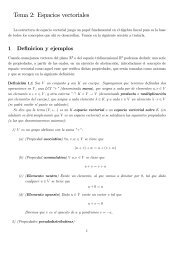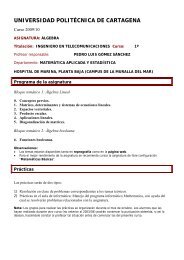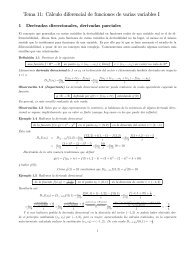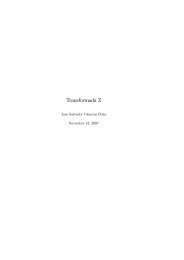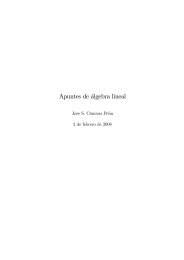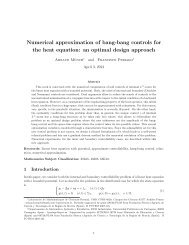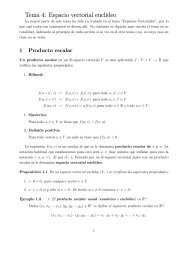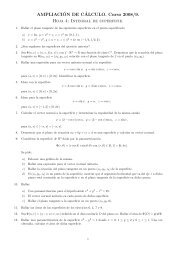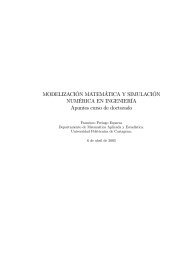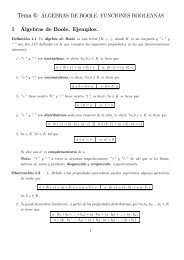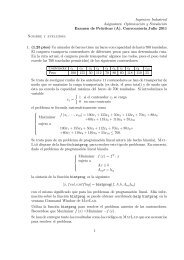7.10. Calcular el desarrollo de Taylor de grado 2 en x = 0 de la ...
7.10. Calcular el desarrollo de Taylor de grado 2 en x = 0 de la ...
7.10. Calcular el desarrollo de Taylor de grado 2 en x = 0 de la ...
You also want an ePaper? Increase the reach of your titles
YUMPU automatically turns print PDFs into web optimized ePapers that Google loves.
<strong>7.10.</strong> <strong>Calcu<strong>la</strong>r</strong> <strong>el</strong> <strong><strong>de</strong>sarrollo</strong> <strong>de</strong> <strong>Taylor</strong> <strong>de</strong> <strong>grado</strong> 2 <strong>en</strong> x = 0 <strong>de</strong> <strong>la</strong> funciónf (x) =∫ x0te −t dt,y utilizarlo para calcu<strong>la</strong>r aproximadam<strong>en</strong>te ∫ 0,10te −t dt. Dar una estimación d<strong>el</strong>error cometido. (1–12–1997).7.11. <strong>Calcu<strong>la</strong>r</strong> <strong>el</strong> sigui<strong>en</strong>te límite funcional1 − cos 3xlím (14–2–1998).x→0 s<strong>en</strong> x 27.12. <strong>Calcu<strong>la</strong>r</strong> <strong>el</strong> límites<strong>en</strong> x − x + ax3lím1+bx 2(2–7–1998).x→0 ln(x +1)7.13. Usando <strong>el</strong> <strong><strong>de</strong>sarrollo</strong> <strong>de</strong> <strong>Taylor</strong> <strong>en</strong> x =0<strong>de</strong>f(x) =e x √, obt<strong>en</strong>er 3 e con un errorm<strong>en</strong>or que 10 −4 . (2–7–1998).7.14. Utiliza un <strong><strong>de</strong>sarrollo</strong> <strong>de</strong> <strong>Taylor</strong> <strong>de</strong> or<strong>de</strong>n 2 <strong>de</strong> <strong>la</strong> función f(x) = log x paraaproximar <strong>el</strong> valor <strong>de</strong> log(1, 1). Da una estimación d<strong>el</strong> error cometido.7.15. Calcu<strong>la</strong> los límites sigui<strong>en</strong>tes:x(a) lím 5 −x log(1+x 4 )s<strong>en</strong>x→0 s<strong>en</strong> 3 (x 2 )(b) lím 3 (x 2 )x→0 x 5 −x log(1+x 4 )[1−cos(c) lím 2 (x 2 )]s<strong>en</strong> 3 (x)log(1+xx→0 x log(1+x 6 )(d) lím 3 )x→0 1−cos 3 (x)7.16. Calcu<strong>la</strong> <strong>el</strong> límite sigui<strong>en</strong>te utilizando <strong><strong>de</strong>sarrollo</strong>s <strong>de</strong> <strong>Taylor</strong>log(1 + x 2 )s<strong>en</strong> (2x 4 )límx→0 x 3 log(1 + 3x 3 )7.17. Calcu<strong>la</strong> <strong>el</strong> límite sigui<strong>en</strong>te usando <strong><strong>de</strong>sarrollo</strong>s <strong>de</strong> <strong>Taylor</strong>:2s<strong>en</strong> x 4límx→0 1 − cos (x 2 )32VIII.Cálculo integral: funciones reales <strong>de</strong> variable real8.1. <strong>Calcu<strong>la</strong>r</strong> <strong>la</strong>s sigui<strong>en</strong>tes integrales <strong>de</strong>finidas:(a) ∫ 10 xex dx(b) ∫ π/20s<strong>en</strong> xdx(c) ∫ 21log xdx(d) ∫ ba xp dx, don<strong>de</strong> p es un número <strong>en</strong>tero negativo.8.2. <strong>Calcu<strong>la</strong>r</strong> <strong>la</strong> <strong>de</strong>rivada <strong>de</strong> <strong>la</strong>s sigui<strong>en</strong>tes funciones:(a) F (x) = ∫ x ( )0 1+t2 −3dt(b) F (x) = ∫ x ( ) 20 1+t2 −3dt(c) F (x) = ∫ x 2t 6x 3 1+tdt 48.3. Si<strong>en</strong>do f (x) una función continua, calcu<strong>la</strong>r <strong>la</strong>s sigui<strong>en</strong>tes <strong>de</strong>rivadas:(a) F (x) = ∫ πxf (t) dt(b) F (x) = ∫ πxxf (t) dt(c) F (x) = ∫ s<strong>en</strong> xx(d) F (x) = ∫ s<strong>en</strong> xx(e) F (x) = ∫ s<strong>en</strong> xxf (t) dtlog xf (t) dtlog tf (t) dt8.4. Hal<strong>la</strong>r los extremos r<strong>el</strong>ativos <strong>de</strong> <strong>la</strong> funciónF (x) =∫ x0te −t dt.8.5. Sea f : R → R una función continua y periódica, <strong>de</strong> periodo T, esto es,f (x + T )=f (x) para todo número real x. Demostrar que <strong>la</strong> función <strong>de</strong>finidapor F (x) = ∫ x+Txf (t) dt es constante.8.6. Sea f : R → R una función continua. Demostrar que para todo par <strong>de</strong> númerosreales a
8.8. Hal<strong>la</strong> <strong>el</strong> área <strong>de</strong> <strong>la</strong> región d<strong>el</strong> p<strong>la</strong>no S situada <strong>en</strong>tre <strong>la</strong>s gráficas <strong>de</strong> <strong>la</strong>s funcionesf (x) =x (x − 2) y g (x) =x/2, sobre <strong>el</strong> intervalo [0, 2] .8.9. Hal<strong>la</strong> <strong>el</strong> área d<strong>el</strong> recinto limitado por <strong>la</strong>s curvas <strong>de</strong> ecuaciones y = x 3 − 12x ey = x 2 .8.10. Hal<strong>la</strong> <strong>el</strong> área d<strong>el</strong> recinto limitado por <strong>la</strong>s curvas <strong>de</strong> ecuaciones y = xs<strong>en</strong> x ey = x.8.11. Hal<strong>la</strong> <strong>el</strong> volum<strong>en</strong> d<strong>el</strong> sólido g<strong>en</strong>erado al girar <strong>la</strong> región limitada por <strong>la</strong>s gráficas<strong>de</strong> <strong>la</strong>s curvasy = x 3 ,x=0,x=1,alre<strong>de</strong>dor d<strong>el</strong> eje x.8.12. Hal<strong>la</strong> <strong>el</strong> volum<strong>en</strong> d<strong>el</strong> sólido g<strong>en</strong>erado al girar <strong>la</strong> región limitada por <strong>la</strong>s gráficas<strong>de</strong> <strong>la</strong>s curvasy =6x − x 2 ,y=0,alre<strong>de</strong>dor d<strong>el</strong> eje y.8.13. Hal<strong>la</strong> <strong>el</strong> volum<strong>en</strong> d<strong>el</strong> sólido g<strong>en</strong>erado al girar <strong>el</strong> triángulo <strong>de</strong> vértices (1, 2) ,(9, 0) , (4, 5) , alre<strong>de</strong>dor d<strong>el</strong> eje x.8.14. Hal<strong>la</strong> <strong>el</strong> volum<strong>en</strong> d<strong>el</strong> sólido g<strong>en</strong>erado al girar alre<strong>de</strong>dor <strong>de</strong> <strong>la</strong> recta 0 = x +1, <strong>el</strong>recinto limitado por <strong>la</strong>s curvasy =(x +1) −1 ,y=0,x=1,x=0.8.21. P<strong>la</strong>ntea <strong>la</strong> <strong>de</strong>scomposición <strong>en</strong> fracciones simples (sin necesidad <strong>de</strong> calcu<strong>la</strong>r <strong>la</strong>sconstantes) <strong>de</strong> p(x)q(x) , don<strong>de</strong>: p(x) =x2 +x+x y q(x) =(x 2 +4) 3 (x−7) 2 (x 2 +x+1).8.22. Calcu<strong>la</strong> <strong>el</strong> área <strong>de</strong> <strong>la</strong> figura limitada por xy = a 2 yporx + y = 5 2a, si<strong>en</strong>do a unaconstante estrictam<strong>en</strong>te positiva.8.15. <strong>Calcu<strong>la</strong>r</strong> <strong>el</strong> área y <strong>el</strong> volum<strong>en</strong> <strong>de</strong> una circunfer<strong>en</strong>cia y una esfera <strong>de</strong> radio R.8.16. <strong>Calcu<strong>la</strong>r</strong> <strong>el</strong> área <strong>de</strong> una <strong>el</strong>ipse <strong>de</strong> semiejes a, b.8.17. <strong>Calcu<strong>la</strong>r</strong> <strong>el</strong> volum<strong>en</strong> <strong>de</strong> un cilindro <strong>de</strong> altura h y radio <strong>de</strong> <strong>la</strong> base r.8.18. <strong>Calcu<strong>la</strong>r</strong> <strong>el</strong> volum<strong>en</strong> <strong>de</strong> un cono <strong>de</strong> altura h y radio <strong>de</strong> <strong>la</strong> base r.8.19. Calcu<strong>la</strong> <strong>la</strong> longitud <strong>de</strong> una circunfer<strong>en</strong>cia <strong>de</strong> radio R.8.20. Usar <strong>la</strong>s reg<strong>la</strong>s <strong>de</strong> trapecio y Simpson para calcu<strong>la</strong>r <strong>de</strong> forma aproximada <strong>la</strong>ssigui<strong>en</strong>tes integrales con un error m<strong>en</strong>or que 10 −2 :(a) ∫ 10 e−x dx.(b) ∫ 10 xe−x dx.(c) ∫ 10 x2 s<strong>en</strong> xdx.(d) ∫ 1 (∫ x0 0 s<strong>en</strong> tdt) dx.(e) ∫ 10 s<strong>en</strong> xe−x dx.3435
IX.Cálculo integral: integración numérica e integrales impropias(e) ∫ ∞0(f) ∫ ∞1√1dxx(1+ex )√1dx(x−1)(9−x2 )379.1. Comprobar que <strong>la</strong> fórmu<strong>la</strong> d<strong>el</strong> trapecio es exacta para polinomios <strong>de</strong> <strong>grado</strong> 1, es<strong>de</strong>cir, si f (x) es un polinomio <strong>de</strong> <strong>grado</strong> 1, <strong>en</strong>tonces para todo par <strong>de</strong> númerosreales a
X. Cálculo integral: funciones reales <strong>de</strong> varias variables10.1. <strong>Calcu<strong>la</strong>r</strong> para Ω = [0, 1] × [0, 3] <strong>la</strong>s integrales(a) ∫∫ Ω xydxdy. (b) ∫∫ Ω xey dxdy. (c) ∫∫ Ω y2 s<strong>en</strong> xdxdy.10.2. <strong>Calcu<strong>la</strong>r</strong> <strong>la</strong>s integrales dobles sigui<strong>en</strong>tes <strong>en</strong> los recintos que se indican:a) ∫∫ Ω ydxdy <strong>en</strong> Ω = {(x, y) ∈ R2 : x 2 + y 2 ≤ 1}.b) ∫∫ Ω (3y3 + x 2 )dxdy <strong>en</strong> Ω = {(x, y) ∈ R 2 : x 2 + y 2 ≤ 1, }.c) ∫∫ √Ω xydxdy <strong>en</strong> Ω = {(x, y) ∈ R 2 :0≤ y ≤ 1, y 2 ≤ x ≤ y}.d) ∫∫ Ω yex dxdy <strong>en</strong> Ω = {(x, y) ∈ R 2 :0≤ y ≤ 1, 0 ≤ x ≤ y 2 }.e) ∫∫ Ω y + log xdxdy <strong>en</strong> Ω = {(x, y) ∈ R2 :0,5 ≤ x ≤ 1, x 2 ≤ y ≤ x}.10.3. <strong>Calcu<strong>la</strong>r</strong> <strong>la</strong>s integrales dobles sigui<strong>en</strong>tes <strong>en</strong> los recintos que a continuación sedan:a) ∫∫ Ω (4 − y2 )dxdy <strong>en</strong> <strong>el</strong> recinto limitado por <strong>la</strong>s ecuaciones y 2 =2x e y 2 =8 − 2x.b) ∫∫ Ω (x4 + y 2 )dxdy <strong>en</strong> <strong>el</strong> recinto limitado por y = x 3 e y = x 2 .c) ∫∫ Ω (x + y)dxdy <strong>en</strong> <strong>el</strong> recinto limitado por y = x3 e y = x 4 con −1 ≤ x ≤ 1.d) ∫∫ Ω (3xy2 − y)dxdy <strong>en</strong> <strong>la</strong> región limitada por y = |x|, y = −|x| y x ∈ [−1, 1].10.4. <strong>Calcu<strong>la</strong>r</strong> <strong>la</strong> superficie <strong>de</strong> <strong>la</strong>s sigui<strong>en</strong>tes regiones:a) Círculo <strong>de</strong> radio R.b) Elipse <strong>de</strong> semiejes a, b.c) La región limitada por <strong>la</strong>s ecuaciones x 2 =4y y2y − x − 4=0.d) La región limitada por <strong>la</strong>s ecuaciones x + y =5yxy =6.e) La región limitada por <strong>la</strong>s ecuaciones x = y y x =4y − y 2 .10.5. <strong>Calcu<strong>la</strong>r</strong> <strong>el</strong> volum<strong>en</strong> <strong>de</strong> los sigui<strong>en</strong>tes sólidos:a) El limitado por x 2 + y 3 + z 4= 1 y los p<strong>la</strong>nos <strong>de</strong> coor<strong>de</strong>nadas.b) El tronco limitado superiorm<strong>en</strong>te por z =2x +3y e inferiorm<strong>en</strong>te por <strong>el</strong>cuadrado [0, 1] × [0, 1].c) Esfera <strong>de</strong> radio R.38d) Cono <strong>de</strong> altura h y radio <strong>de</strong> <strong>la</strong> base R.e) El tronco limitado superiorm<strong>en</strong>te por <strong>la</strong> ecuación z =2x + 1 e inferiorm<strong>en</strong>tepor <strong>el</strong> disco (x − 1) 2 + y 2 ≤ 1.10.6. <strong>Calcu<strong>la</strong>r</strong> cambiando a coor<strong>de</strong>nadas po<strong>la</strong>res:a) ∫ 1 ∫ √ 1−y √ 2−1 0 x2 + y 2 dxdy.b) ∫ 2 ∫ √ 4−x√ 20 0 x2 + y 2 dydx.c) ∫ 1 ∫ √ 1−x 21/2 0(x 2 + y 2 ) 3/2 dydx.d) ∫ 1/20∫ √ 1−y 20 xy √ x 2 + y 2 dxdy.10.7. <strong>Calcu<strong>la</strong>r</strong> para Ω = [0, 1] × [0, 3] × [−1, 1] <strong>la</strong>s integrales(a) ∫∫∫ Ω xyzdxdydz. (b) ∫∫∫ Ω xey+z dxdydz. (c) ∫∫∫ Ω y2 z 3 s<strong>en</strong> xdxdydz.10.8. <strong>Calcu<strong>la</strong>r</strong> <strong>la</strong>s integrales que a continuación se pi<strong>de</strong>n <strong>en</strong> los recintos correspondi<strong>en</strong>tes:a) ∫∫∫ Ω (y3 + z + x)dxdydz <strong>en</strong> Ω = {(x, y, z) ∈ R 3 : x 2 + y 2 + z 2 =1}.b) ∫∫∫ Ω (ys<strong>en</strong> z + x)dxdydz <strong>en</strong> Ω = {(x, y, z) ∈ R3 : y ≥ z ≥ y 2 , 0 ≤ x, y ≤ 1}.c) ∫∫∫ Ω xdxdydz <strong>en</strong> Ω = {(x, y, z) ∈ R3 :1≥ y 2 + x 2 , 0 ≤ z ≤ 1}.d) ∫∫∫ Ω yxzdxdydz <strong>en</strong> Ω = {(x, y, z) ∈ R3 : −5 ≤ z ≤ y 2 + x, −1 ≤ x, y ≤ 1}.10.9. <strong>Calcu<strong>la</strong>r</strong> <strong>el</strong> volum<strong>en</strong> d<strong>el</strong> sólido limitado superiorm<strong>en</strong>te por z = 1 e inferiorm<strong>en</strong>tepor z = √ x 2 + y 2 .10.10. <strong>Calcu<strong>la</strong>r</strong> <strong>el</strong> volum<strong>en</strong> d<strong>el</strong> sólido limitado superiorm<strong>en</strong>te por <strong>el</strong> cilindro parabólicoz =1− y 2 , inferiorm<strong>en</strong>te por <strong>el</strong> p<strong>la</strong>no 2x +3y + z + 10 = 0 y <strong>la</strong>teralm<strong>en</strong>te por<strong>el</strong> cilindro circu<strong>la</strong>r x 2 + y 2 + x =0.10.11. Hal<strong>la</strong>r <strong>el</strong> volum<strong>en</strong> d<strong>el</strong> sólido limitado por los paraboloi<strong>de</strong>s <strong>de</strong> ecuaciones z =2 − x 2 − y 2 y z = x 2 + y 2 .10.12. <strong>Calcu<strong>la</strong>r</strong> <strong>el</strong> volum<strong>en</strong> d<strong>el</strong> sólido limitado superiorm<strong>en</strong>te por <strong>la</strong> superficie cilíndricax 2 + z = 4, inferiorm<strong>en</strong>te por <strong>el</strong> p<strong>la</strong>no x + z = 2 y <strong>la</strong>teralm<strong>en</strong>te por los p<strong>la</strong>nosy =0ey =3.10.13. Haci<strong>en</strong>do uso <strong>de</strong> <strong>la</strong>s coor<strong>de</strong>nadas esféricas x = rs<strong>en</strong> φcos θ, y = rs<strong>en</strong> φs<strong>en</strong> θ yz = rcos φ, calcu<strong>la</strong>r:a) El volum<strong>en</strong> <strong>de</strong> una esfera <strong>de</strong> radio R.b) ∫∫∫ Ω (x2 +y 2 +z 2 )dxdydz <strong>en</strong> <strong>el</strong> recinto Ω = {(x, y, z) ∈ R 3 :1≤ x 2 +y 2 +z 2 ≤2}.39
c) El volum<strong>en</strong> d<strong>el</strong> recinto d<strong>el</strong> apartado (b).10.14. <strong>Calcu<strong>la</strong>r</strong> <strong>el</strong> volum<strong>en</strong> d<strong>el</strong> cuerpo limitado por <strong>la</strong>s ecuaciones z = x 2 +4y 2 , <strong>el</strong> p<strong>la</strong>noz = 0 y <strong>la</strong>teralm<strong>en</strong>te por los cilindros x = y 2 y x 2 = y.10.15. <strong>Calcu<strong>la</strong>r</strong> ∫∫ Ω e x−yx+y dxdy si<strong>en</strong>do Ω <strong>el</strong> triángulo formado por los ejes <strong>de</strong> coor<strong>de</strong>nadasy <strong>la</strong> recta x + y =1.10.16. <strong>Calcu<strong>la</strong>r</strong> <strong>el</strong> volum<strong>en</strong> compr<strong>en</strong>dido <strong>en</strong>tre los cilindros z = x 2 y z =4− y 2 .10.17. <strong>Calcu<strong>la</strong>r</strong> <strong>el</strong> volum<strong>en</strong> d<strong>el</strong> balón <strong>de</strong> Rugby <strong>de</strong> ecuaciones x2a+ y22 b+ z22 c=1.210.18. <strong>Calcu<strong>la</strong>r</strong> ∫∫ Ωxydxdy don<strong>de</strong> Ω es <strong>la</strong> región limitada por <strong>la</strong>s curvas y =2x, y =2x − 2, y = x e y = x + 1. Indicación: hacer <strong>el</strong> cambio <strong>de</strong> variable x = u − v,y =2u − v.10.19. <strong>Calcu<strong>la</strong>r</strong> <strong>el</strong> volum<strong>en</strong> <strong>en</strong>cerrado por un cilindro <strong>de</strong> radio R/2 y una esfera <strong>de</strong> radioR cuyo c<strong>en</strong>tro está situado <strong>en</strong> un punto <strong>de</strong> <strong>la</strong> superficie d<strong>el</strong> cilindro. Indicación:hacer <strong>el</strong> cambio a coor<strong>de</strong>nadas cilíndricas.10.20. <strong>Calcu<strong>la</strong>r</strong> ∫∫∫dxdydzΩ (x 2 + y 2 + z 2 ) 3/2,don<strong>de</strong> Ω es <strong>la</strong> región limitada por <strong>la</strong>s esferas x 2 +y 2 +z 2 = a 2 y x 2 +y 2 +z 2 = b 2 ,don<strong>de</strong> 0



